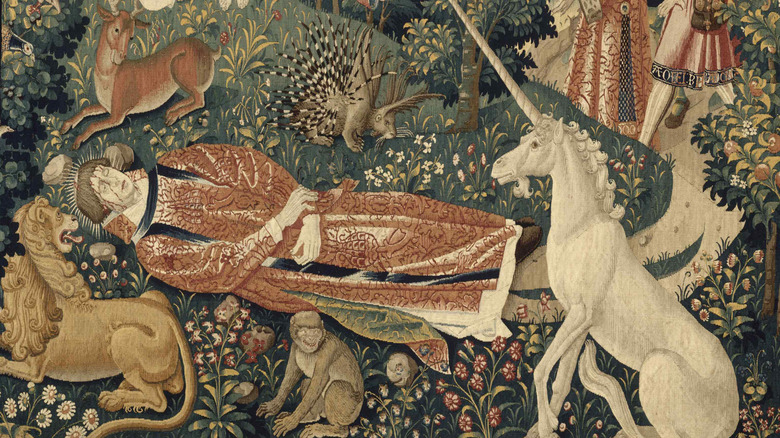Are Unicorns Ever Mentioned In The Bible?
The unicorn, a mythical creature that can strike enemies with the single horn on its forehead, appeared in folklore early — on Mesopotamian artwork and mentioned in ancient Indian and Chinese tales, according to Britannica.
In Greek literature, stories of a strange animal were recorded by the historian Ctesias around 400 BCE, who describe an Indian wild ass that sported blue eyes in its purple head and had a white body with a multi-colored horn — red at the tip, white at the bottom, and black in between. The horn possessed a magic that protected anyone who drank from it against the evils of stomachaches, epileptic episodes, and poisons. Was this real? Maybe not, but many believe the description evoked Indian rhinoceros characteristics.
In fairy tales, unicorns take on a purer presence with their untainted white coats, a bouncy and flowing mane, and a long elegant spiral atop its head, said the American Museum of Natural History. While these childhood stories offered a poetic version of the unicorn, the oldest accounts echo Ctesias' depiction of a colored horn on a more goat-like body. People hungered for unicorn accounts and only a small number ever questioned the animal's existence; many of the first naturalists even thought the unicorn was part of the animal kingdom and were inserted into detailed record catalogs, such as Konrad Gesner in 1551's "Historiae Animalium," offering that the creatures lived solitary lives and occasionally fought lions and elephants. The unicorn also came to be seen as a symbol for Jesus Christ.
From Bible translations to a national day
The legendary animal appears in the Bible, depending on which translation you consult. Some time in 250 BCE the Hebrew Scriptures were translated into Greek, and the scholars became puzzled by the word re'em. According to Unicorns Rule, it probably referred to a single-horned wild ox that died off long ago and had no known name. The Greeks dubbed it monokeros, which translates to one-horned. Later, St. Jerome created a Latin translation of the Bible, and wrote the word as unicornis. When the Bible got an English translation in 1611, that became the modern-day word unicorn.
The word appears in the King James translation of the Bible nine times. Both Numbers 23:22 and 24:8 talk about a unicorn's hefty strength; Deuteronomy 33:17, Psalm 22:21, and Psalm 92:10 mention its piercing horn; Job 39:10 and 39:10 speak about how the unicorn wasn't domesticated and never tilled the earth; and while the Bible never offer vivid descriptions of the animal, it does mention in Psalm 29:6, that its gait is similar to a skipping calf. Isaiah 34:7 compares the creature to bulls and bullocks.
Art historians link the unicorn to Jesus Christ, citing comparable stories and visual work where a unicorn purifies water for other animals by touching its horn to the surface, explained the American Museum of Natural History, contrasting it with Christ's sacrifice on the cross to reconcile mankind's sins.
Today the unicorn still resonates. It is the national animal of Scotland, and National Unicorn Day is celebrated yearly on April 9.

